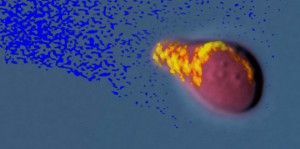New Understanding of the Sense of Smell in Cells
A common problem faced by cells is that they are surrounded by a promising cloud of smell, and you must determine the direction of their origin. For example, nerve cells, forming long extensions, are attracted to signals from other cells to produce a network that forms the nervous system; similarly, scavenger cells can recognize the smell of harmful bacteria, so that they can catch and destroy them.
However, how do cells perceive these signals--as distance increases the signal becomes weaker and weaker? How do cells "read" the weakening signal—technically known as a signal gradient to guide their growth or movement towards the source of the signal? How space signals are perceived is a basic problem faced by the biological-and until now this riddle has not been solved.
 The polarity site (yellow traces) is a sensor, processor and motor all in one – a multifunctional instrument that controls cell growth and movement. From Sciencedaily.
The polarity site (yellow traces) is a sensor, processor and motor all in one – a multifunctional instrument that controls cell growth and movement. From Sciencedaily.Now, researchers led by ETH Professor Matthias Peter of the Institute of Biochemistry have presented a possible solution. Yeast cells have a very good, adjustable multi-tool to identify chemical signals, process them accordingly, and start the correct response - growth towards the source of the signal. Thus, yeast cells will be able to smell the location of potential partner in the surroundings, so that they can grow towards them. The biologists carried out the study by using micro-observations and computer models that are developed through interdisciplinary cooperation. The research results were published recently in the journal Developmental Cell.
If the cell suspects that a signal gradient is nearby, it assembles this multi-tool at a random position on the cell membrane. This tool is a large protein complex formed by more than 100 different chemical components; its complexity is so great thay it can be observed by a fluorescence microscope. The researchers referred this as a 'polar site' (PS), because polarized growth sets in at the location where it forms. Using a fluorescent microscope, the researchers observed how the PS locates the source of a gradient signal.
In order to understand the molecular mechanics of this process, the researchers referred to the computer model. "This model really helped us to reduce the complexity of the PS and the process to a few essential components," says Björn Hegemann, lead author of the study.
The ETH researchers have now provided this interpretation and firstly described in detail how cells can locate a scent gradient. This work havs laid an important foundation for further studies on spatial signal perception by cells- whether in yeast or human, According to Hegemann, at present there is no direct medical application envisaged: "In the distant future, this work might well benefit the general public. At the moment, however, it primarily represents an important advance for fundamental research."
Journal Reference:
Björn Hegemann, Michael Unger, Sung Sik Lee, Ingrid Stoffel-Studer, Jasmin van den Heuvel, Serge Pelet, Heinz Koeppl, Matthias Peter. A Cellular System for Spatial Signal Decoding in Chemical Gradients. Developmental Cell, 2015; 35 (4): 458 DOI: 10.1016/j.devcel.2015.10.013

Your email address will not be published. Required fields are marked *